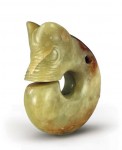“Beautiful stones” and jade
 In making and polishing stone tools, prehistory Chinese found that some stones are exceptionally beautiful with smooth surfaces and lustrous colors. Such stones were broadly referred to as yu, which means “jade”. In Studies of the Principles on Composition of Characters, the very first Chinese dictionary compiled by Xu Shen of the East Han Dynasty (25-220 AD), the character yu is denoted as “beautiful stones”. The so-called “beautiful stones” are not exactly what is termed as “jade” in modern mineralogy. Modern mineralogy classifies jade into “hard jade”, in fact jadeite, which is as hard as glass or even harder, and “soft jade”, which is less hard than glass. To put it in scientific language, hard jade has a 7-degree Vicker’s hardness or greater, while soft jade is leas hard. “Beautiful stones” are none other than “soft jade”, which is good for carving.
In making and polishing stone tools, prehistory Chinese found that some stones are exceptionally beautiful with smooth surfaces and lustrous colors. Such stones were broadly referred to as yu, which means “jade”. In Studies of the Principles on Composition of Characters, the very first Chinese dictionary compiled by Xu Shen of the East Han Dynasty (25-220 AD), the character yu is denoted as “beautiful stones”. The so-called “beautiful stones” are not exactly what is termed as “jade” in modern mineralogy. Modern mineralogy classifies jade into “hard jade”, in fact jadeite, which is as hard as glass or even harder, and “soft jade”, which is less hard than glass. To put it in scientific language, hard jade has a 7-degree Vicker’s hardness or greater, while soft jade is leas hard. “Beautiful stones” are none other than “soft jade”, which is good for carving.
Jade, or “soft jade” to be exact, became the sole “beautiful stone” for making art objects with during the Shang-Zhou period (1,600 BC – 256 BC). The earliest jade artifacts known to us are personal ornaments produced about 7,000 years ago, including hairpins for men, as well as beads and eardrops. These were excavated from the fourth cultural stratum of the Hemudu ruins on the lower reaches of the Yangtze River and the Banpo ruins in Xi’an, Shanxi Province. Immediately after their birth, jade artifacts came to be valued for a unique aesthetic beauty relative to stone, wooden, bone and pottery objects and were taken as symbols for monarchical powers represented by military chieftains and divine powers by wizards. In the most recent three decades, large numbers of jade artifacts have been unearthed from tombs of aristocrats that date back to the Neolithic Era, the Shang-Zhou period and the Qin and Han dynasties. Some of these belong to the Hongshan and Liangzhu cultures.
art objects with during the Shang-Zhou period (1,600 BC – 256 BC). The earliest jade artifacts known to us are personal ornaments produced about 7,000 years ago, including hairpins for men, as well as beads and eardrops. These were excavated from the fourth cultural stratum of the Hemudu ruins on the lower reaches of the Yangtze River and the Banpo ruins in Xi’an, Shanxi Province. Immediately after their birth, jade artifacts came to be valued for a unique aesthetic beauty relative to stone, wooden, bone and pottery objects and were taken as symbols for monarchical powers represented by military chieftains and divine powers by wizards. In the most recent three decades, large numbers of jade artifacts have been unearthed from tombs of aristocrats that date back to the Neolithic Era, the Shang-Zhou period and the Qin and Han dynasties. Some of these belong to the Hongshan and Liangzhu cultures.